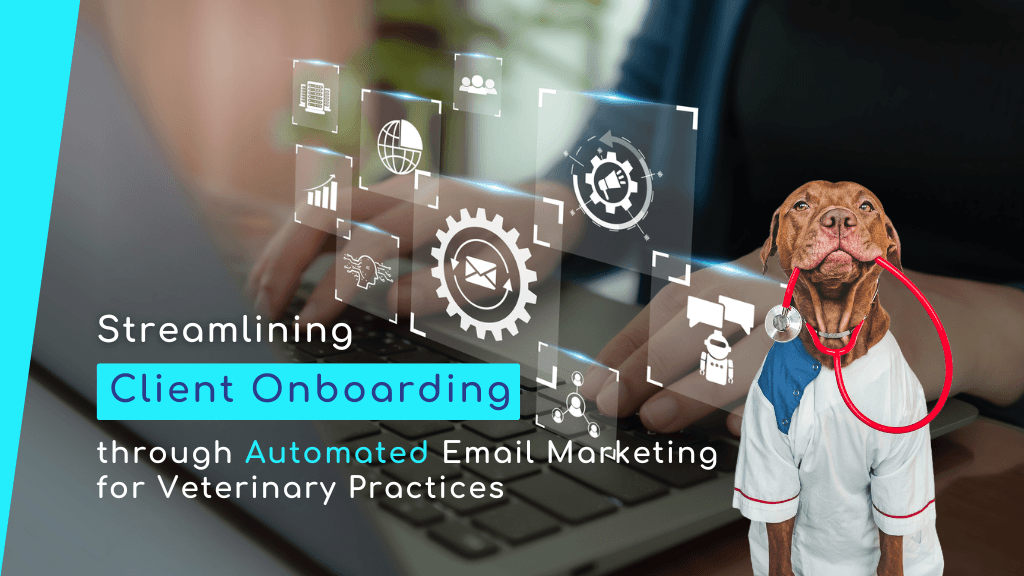Streamlining Client Onboarding through Automated Email Marketing for Veterinary Practices
)
In the realm of veterinary practices in Australia, the importance of a positive onboarding experience for client retention and loyalty cannot be overstated. Research reveals that a staggering 76% of clients who undergo a welcoming onboarding process are more inclined to continue their patronage. This compelling statistic underscores the necessity for veterinary businesses to invest in an effective onboarding process, as it directly impacts long-term client engagement.
Moreover, data suggests that well-executed onboarding can boost client retention by up to 50%, highlighting the significant impact a refined onboarding strategy can have on a practice's success. In a competitive market landscape, enhancing the client onboarding journey becomes paramount to secure client satisfaction and loyalty.
Investing substantial time, resources, and effort in acquiring new clients underscores the importance of maximising this investment by enhancing their onboarding experience. By doing so, veterinary practices not only prolong client engagement but also increase the likelihood of additional appointments and referrals. It's surprising that 90% of businesses overlook this critical aspect, which yields considerable rewards. Prioritising an exceptional onboarding process is a strategic move that can set a veterinary practice apart, ensuring a higher return on the initial client acquisition investment. Especially when leveraging tools that can automate most of this process - where it's done once and keeps delivering results consistently.
Maximising Client Onboarding Efficiency with Automated Email Marketing
For veterinary practices, utilising emails to onboard new clients presents a strategy laden with benefits, particularly due to its efficiency and effectiveness in engaging clients. Email marketing, when utilised as the backbone of the onboarding process, offers a seamless, automated approach that continues to deliver value without requiring constant effort. This automation allows practices to set up a series of informative, welcoming emails once and then benefit from this system working tirelessly in the background, onboarding new clients time and again.
The effectiveness of email as a tool for onboarding should not be underestimated. Statistics show that onboarding emails command some of the highest levels of client engagement. Specifically, welcome messages enjoy a 42% higher read rate compared to average emails. This elevated level of engagement offers a golden opportunity for veterinary practices to initiate and deepen communication channels with their clients. By leveraging the high engagement rates of welcome emails, practices can start building a foundation of trust from the very first interaction.
In short, automated email marketing for onboarding combines the ease of automation with the effectiveness of personalised communication, enabling veterinary practices to efficiently scale their onboarding process while creating strong, trusting relationships with new clients.
- Welcome Message: A warm introduction that thanks the client for choosing your veterinary practice.
- Practice Overview: Brief insight into your practice's mission, values, and what sets you apart.
- Service Information: Key services and benefits tailored to the client's pet care needs.
- Getting Started Guide: Step-by-step instructions or tips to help clients understand your practice procedures and services.
- Video Tutorials: Links to video guides that visually demonstrate how to care for their pets or use your services.
- Pet Care Tips and Best Practices: Helpful advice or strategies to maximise the health and wellbeing of their pets.
- FAQs: Answers to common questions new clients might have about your practice or pet care.
- Client Support Information: Details on how to get in touch for support, including email addresses, phone numbers, and hours of operation.
- Account Management Tools: Instructions for managing their pet's account, including setting appointments, updating information, or accessing medical records.
- Feedback Request: Encouragement to provide feedback on their introduction experience or their pet's early experiences with your practice.
- Community Engagement: Invitation to join online forums, social media groups, or community events to connect with other pet owners.
- Upcoming Events or Services: Preview of upcoming events, services, or promotions clients can look forward to.
- Testimonials: Success stories or testimonials from satisfied clients to build credibility and trust.
- Personalised Recommendations: Based on their pet's health history, suggest additional preventive care or treatments that might be beneficial.
Key Steps to Crafting Compelling Onboarding Emails Tailored for Veterinary Practices
Crafting an effective onboarding email is pivotal in setting the stage for clients' journey with a veterinary practice's services. Here’s how to create one that engages and converts:
- Write a Catchy Subject Line: Your subject line is the gateway to your onboarding email. It needs to be compelling enough to make clients want to open your email. Think of it as the hook that draws them in; it should be action-oriented, benefit-focused, and concise to capture attention immediately. For instance, subject lines like "Welcome to [Veterinary Practice Name] - Your Pet's Wellness Journey Begins!" can be engaging and promising.
- Restate Your Value Proposition: Once you've got their attention, reinforce why they chose you. Your email should clearly articulate the unique benefits your veterinary practice offers, aligning with their pet's healthcare needs or concerns.
- Show the Next Onboarding Steps: Guide your clients through the initial process of scheduling an appointment, providing medical history, or preparing for their first visit. Make these steps clear and easy to follow to reduce any friction in starting to use your veterinary services.
- Generate the 'A-ha' Moment: Your goal is to quickly bring clients to the realisation of your veterinary practice’s value—the "aha" moment. Highlight the core value of your services and guide them through any necessary actions to experience this value firsthand.
- Add Helpful Resources: Support your clients by providing resources that help them understand pet healthcare or prepare for their visit. Include links to informative articles, FAQs, or testimonials that reassure them of your expertise and care for their pets.
- Provide Customer Service Contact Information: Make sure your clients know how to reach you if they have any questions or concerns. Incorporating personal contact information in your onboarding email not only builds trust but also shows that you are readily available to help, further driving client loyalty.
- Conclude with a Call to Action: End your email with a strong call-to-action (CTA) that encourages clients to schedule their first appointment or explore your services further. A clear, compelling CTA removes any ambiguity about what to do next, making it easier for them to begin their pet's healthcare journey with your veterinary practice.
- Personalise Your Message: Use email marketing software to personalise the message with the client's name, pet's name, and even previous interactions or pet health history - you are only limited to what you gather in your client database. Personalised emails make clients feel more connected to your practice and show that you care about their individual needs.
- Automate Your Emails and Analyse Results: Use your email marketing system to automate the process once clients register with your practice. Set up a series of trigger emails to automatically go out after specific intervals. Schedule time regularly to analyse the performance of your emails, checking the open rates and click-through rates to refine your strategy and improve results.
By following these steps and tailoring them to the specific needs and interests of pet owners, veterinary practices in Australia can craft onboarding emails that not only welcome clients but also equip them with everything they need to start their pet's healthcare journey smoothly.
Mastering Introduction: The Ideal Email Sequence & Frequency
The number of emails in an introduction sequence and their frequency can vary depending on your practice's focus, pet care services offered, and client preferences. However, a strategic approach can ensure effective communication without overwhelming your new clients. Here's a general guideline to follow:
Number of Emails:
3 to 5 emails are typically sufficient for a basic introduction sequence. This range allows you to cover essential information without overwhelming your clients.
For more comprehensive pet care services or specialised treatments, up to 7 to 10 emails might be necessary. These can delve into detailed pet care tips, preventive healthcare advice, and offer more engagement opportunities.
Frequency:
First Email: Send immediately upon registration with your practice. This should be a warm welcome email that thanks the client for choosing your veterinary services and provides essential information about what to expect next.
Second Email: Send within the first 24 to 48 hours. This can introduce key pet care tips or provide guidance on scheduling their pet's first appointment.
Subsequent Emails: Space these out over the next few days to weeks, based on the pet's healthcare needs. A common approach is to gradually decrease frequency, starting with daily emails, then moving to every other day, and eventually to weekly, as needed.
Content Planning:
Early Emails: Focus on introducing your practice's services, pet care tips, and essential information that helps clients get started on their pet care journey.
Middle Emails: Provide deeper insights into preventive healthcare, common pet health concerns, and ways to enhance the wellbeing of their pets.
Later Emails: Encourage engagement, provide advanced pet care tips, and introduce clients to additional services or promotions offered by your practice.
Tips for Success:
Monitor Engagement: Track open rates, click-through rates, and other engagement metrics to adjust your email sequence and frequency based on client interaction.
Segment Your Audience: Tailor the number and content of emails based on pet demographics, medical history, or specific pet care needs for more personalised communication.
Test and Iterate: Experiment with different sequences and frequencies to see what resonates best with your audience. A/B testing subject lines, content, and calls-to-action can provide valuable insights into client preferences.
Remember, the goal of your introduction email sequence is to guide new clients towards providing the best care for their pets with your veterinary practice. Keeping your communication clear, pet-centric, and respectful of your clients' inboxes will ensure a positive start to their pet care journey with your practice.
| Tags:AttractEmail Marketing |




